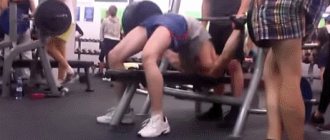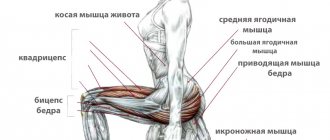The need for aerobic exercise for athletes has already been established, and every bodybuilder should have a place for cardio in his training program. But now another debate has flared up about when to do cardio: at the beginning or end of a workout? Of course, the question is relevant and quite correct. The effectiveness of training is a very important indicator, and since the need for cardio has been scientifically proven, it is necessary to find out at what time a greater effect can be obtained from this type of load. Now there are two camps, representatives of one are confident in the need to use aerobic exercise before starting strength training, and athletes in the second use cardio at the final stage of training. To thoroughly understand this issue, you will have to turn to research.
Research on the effects of cardio
During the experiment, continuous and interval cardio exercise (5-kilometer running), as well as anaerobic training (leg press and bench press) were used.
A total of four test sessions were conducted. The first two used continuous running over a distance of 5 kilometers, as well as anaerobic exercise at a maximum weight and at 80 percent of the working weight. Also, in the remaining two sessions, interval cardio exercise was used in the form of running over a distance of 5 kilometers with a work-to-rest ratio of 1:1. Anaerobic training was similar to the first two sessions.
Upper body and cardio
None of the tests revealed a decrease in endurance and strength in the upper body muscles after cardio exercise.
Legs and cardio
Interval cardio training significantly reduced leg muscle endurance, but had no effect on leg muscle strength. In turn, continuous aerobic exercise did not affect strength and endurance indicators.
Thus, it can be argued that continuous cardio does not affect the muscles of the legs and upper body. But when performing interval cardio exercises, the same motor units are involved in the work, thereby causing the accumulation of a large number of metabolites.
If the intensity of interval cardio exercise is high, then energy for the muscles is obtained through glycolysis. Metabolites of this process form an acidic environment, which subsequently has a negative effect on muscle endurance.
However, these studies are not enough to make a final verdict on the question - when to do cardio: at the beginning or end of the workout? To still find the answer to it, it is necessary to turn to practical experience.
What is cardio?
It refers to well-known exercises for endurance and strengthening the heart and blood vessels. They are performed both in the gym and in nature. Classic examples of cardio training include running and walking, swimming or cycling. In this case, we do not mean short 10-minute runs before the main workout (i.e. warm-up), but continuous exercise for 20 minutes to an hour.
So, we will try to consider the issue of their necessity, duration and proper combination with the main ones. Is it possible to do cardio after strength training, or is it better before it? There is no absolutely clear answer to the question about the ideal method. Cardio can be done in the morning before or after strength training, as well as in the evening or any time you have the energy and free time. Which hour of the day to choose, decide for yourself, depending on your intended goal (and it can come down to muscle growth or weight loss).
Benefits of Cardio Before Strength Training
As you increase your working weight, thanks to aerobic exercise, your muscles will warm up and be better prepared to work with the new weight.
This in turn will increase the intensity of the training. In addition, cardio exercise will be useful for increasing endurance. Of course, there are positive aspects of using aerobic exercise before strength training, and the main one, perhaps, can be considered the preparation of muscles for loads.
Option 4 – high – interval training
There are many options for interval training. The main goal that many people pursue when doing interval training is to combine aerobic and anaerobic training.
Yes, such training makes maximum use of all body systems in the shortest possible time.
Is fat burning increasing?
Increasing.
Does the increased calorie expenditure remain after such training?
Remains.
But such a high intensity is not 100% suitable for beginners and even for those who have been training for about six months. If your level of training is not below average, if you have already used a lot of reserves in your body, then you can try this kind of training, but no more than 2 times a week.
And the most important thing is that when you are ready for interval training, the experience that you will already have accumulated at that time and the level of awareness that you will have will allow you to make the right conclusion on your own regarding what type of interval training to try.
Benefits of Cardio After Strength Training
With sufficiently high cardio loads before strength training, energy reserves may be depleted, which will negatively affect the intensity of the main activity.
It is known that in bodybuilding the most effective for the growth of muscle tissue are the last couple of approaches, which in this case may simply not be enough strength. Also, aerobic exercise helps speed up the burning of fats and carbohydrates, which will also not help increase the intensity of strength training. In addition, it is quite widely believed that after stopping strength training, a large amount of blood collects in the lower part of the body. This is due to the weakening of the cardiovascular system when performing strength exercises.
In turn, if the muscles continue to work in a more “gentle” mode, blood circulation will be restored much faster. Thus, it can be stated that thanks to the use of a treadmill or exercise bike in the final phase of the session, muscle activity will decrease gradually, which will have a beneficial effect on the restoration of blood circulation.
Option 3 – cardio separately from strength training
Theoretically, this is the most ideal way. Practice shows that the theory is correct. This combination option is especially suitable for those who want to preserve muscles and burn fat.
- Anabolic and catabolic processes in this case will be separated in time
- Muscles will have time to recover after strength training
- And cardio training, in addition to strengthening the cardiovascular system, will help with additional calorie consumption and fat burning
Don't forget to monitor your pulse. It is believed that it is best to carry out cardio training at a level of 60-70% of the maximum heart rate (heart rate). Maximum heart rate is calculated using the formula: 220 - age.
Will there be loss of muscle tissue with this option of combining cardio and strength training? If you control your diet and your rest, then such losses can be minimized or avoided altogether.
Cardio before or after strength training?
As you can see from everything written above, it is quite difficult to clearly answer the question of when to do cardio: at the beginning or end of the workout. In both cases there are positive and negative aspects. Perhaps there are three options for using cardio in bodybuilding:
- The first can be used by athletes whose goal is to increase mass. In this case, cardio exercise will be useful at the beginning of the training session.
- If you need to tone your muscles or get rid of excess weight, then the second option is suitable. Aerobic exercise should be given at the initial stage of the lesson before strength training.
- The third option is to separate aerobic and strength exercises on different days. This method of using cardio exercise also seems quite promising.
Well, in conclusion, I would like to say one more look at the question - when to do cardio: at the beginning or end of the workout?
Some athletes use cardio exercises both at the beginning of a training session and at its completion. In this case, moderate aerobic exercise is assumed for 5 to 15 minutes. This approach also seems quite good. Thanks to the low intensity of aerobic exercise, the athlete will be able to warm up his muscles before strength training, acting as a warm-up. After completing the session, cardio will help restore blood circulation and gradually reduce muscle activity. Find out more information about cardio exercises and the optimal time for them in this video:
How to combine cardio and strength training for weight loss?
Excess weight can be different, one needs to lose 10 percent of body weight, another 70. The same for everyone, in order to lose extra pounds, it is necessary to increase daily activity. The more energy is spent, the faster the fat goes away. The most energy-consuming type of activity is cardio or aerobic exercise. Properly designed and carried out aerobic training literally burns fat. For healthy weight loss, it is important to remember that the goal is not just to get rid of fat, but to build muscle mass so that the body becomes healthy, looks beautiful and fit. Cardio refers to any type of low-intensity physical activity. After half an hour of intense exercise, the body's metabolism accelerates, energy is produced from fatty tissue.
Cardio exercises include:
- Walking;
- Running in the fresh air, on a treadmill;
- Dancing;
- Swimming;
- Climbing stairs;
- Ice skating, roller skating;
- Basketball;
- Tennis;
- Bike;
- Ellipse.
Strength and anaerobic exercise will help increase or maintain muscle mass.
Using weights to pump muscle tissue, joints and tendons uses less energy than cardio. The fat burning process is slower. Therefore, it is recommended to alternate aerobic and anaerobic exercises. When creating a program of anaerobic exercise, you should distribute the load between the upper and lower muscle groups. The top groups include:
- Shoulder muscles
- Abdominal Press,
- back muscles,
- Muscles of the chest, arms.
Bottom includes:
- Quadriceps;
- Gluteal;
- Posterior thigh muscle groups.
After anaerobic exercise, you need to give the body one to two days to recover.
During strength training, microtrauma occurs in the muscles under load, lactic acid is released, and muscle swelling occurs, accompanied by pain. Taking a hot bath with the addition of 200 - 400 grams of table or sea salt will help prevent or reduce pain. Thanks to hot water, lactic acid will be painlessly removed from the body. Before each lesson, be sure to warm up, starting from the neck, ending with the feet, stretching each joint of the body. Time 5 - 7 minutes. Finish the set of exercises with a cool down or stretching for 10 minutes. When performing strength exercises, do the first approach as a warm-up. Perform without weights or with light weight, no more than ten repetitions. It is important to work out the technique of performing the exercise, to feel the muscle group being pumped. Below are diagrams and combinations of workouts for weight loss.
Scheme 1 - for beginners.
Two cardio, one strength training, four rest days per week. Aerobic exercises for beginners should take no more than 20 - 30 minutes per workout. When choosing strength exercises, it is necessary to use 2 - 3 muscle groups of the upper or lower body. One exercise is performed 3 sets of 20 repetitions. Rest three minutes between sets. After 2 - 3 weeks of regular exercise, you can move on to scheme 2, gradually increasing the time and weight.
Scheme 2 - increasing the load.
Two cardio, two anaerobic sessions, three recovery days per week. Cardio sessions 30 minutes - 40 minutes per workout: Add or increase weights to anaerobic exercises. Leave the number of repetitions and approaches as in the previous scheme. Depending on the goal and the results obtained, you can leave scheme 2, and for advanced ones, add one more aerobic activity per week. Total per week: three cardio, two strength training sessions, two days of rest.
Scheme 3 - aerobic and anaerobic exercise in one session.
Do 30 minutes of cardio at the beginning of your workout and 20 minutes of strength training at the end. This program will help preserve muscle mass as much as possible. Recommended for use during sports activities twice a week. Important: do not overwork during aerobic training.
Scheme 4 - strength and cardio in one day.
In the first half of the day, do strength exercises, after 5 - 6 hours do cardio. This approach leads to a rapid decrease in both fat and muscle mass, so a break between classes of at least 5 hours is recommended. It should not be included in the training program for beginners.
Scheme 5 -
interval training twice a week.
Effective in losing weight and increasing endurance. The exercises are performed in a circle. Periods of high intensity are followed by periods of recovery. Twenty minutes of interval training can replace an hour of aerobic exercise. Important: for overweight people and without training, exercise should only be done under the supervision of an individual trainer.
A significant percentage of excess weight puts stress on your legs while running, leading to foot and knee injuries. You can replace running with a bicycle, swimming, elliptical or race walking until a rapid heartbeat, slight shortness of breath, and sweating appear. When physical fitness is weak or there are chronic diseases, it is advisable to exercise on light weight machines, under the supervision of a fitness instructor. When drawing up a training program, monitor the correct distribution of load on muscle groups and alternation of rest. When combining cardio with strength training to lose excess weight, you should remember about proper nutrition. Aerobic exercise uses calories and stored fat as fuel. On such days, you should limit foods high in calories. Protein products, meat, fish, eggs, are building materials for the restoration and growth of muscle fibers, and should form the basis of nutrition on days of anaerobic exercise. A slender, toned body is the result of good physical fitness. Regular exercise, patience and healthy self-love will lead to the expected results. When developing a lesson program on your own, a beginner will be faced with many different questions. You should not look for answers on the Internet, from friends or trainers. Take action. As you gradually introduce physical activity, try and apply different techniques, perform exercises before or after meals, add or decrease the number of approaches, listen to how your body responds.
Try it, experiment, put it into practice!
Cardio: Combine or Split?
A favorite combination of athletes and gym goers is cardio training followed by strength training.
Warming up before training and cooling down after it does not count as cardio and lasts 10-15 minutes. Thus, if you decide to combine cardio training with strength training, then the first ones become shorter in time. Aerobic exercise is thought to make it harder to gain muscle mass, but some researchers believe that the right combination of strength training and cardio training can lead to greater hypertrophy than strength training alone. This, for example, is discussed in the work of Dr. Keith Baar, “The Molecular Biology of Getting the Maximum Effect from Combined Training.” However, interestingly, a number of studies have found no positive or negative effect of combined training on muscle protein synthesis.











